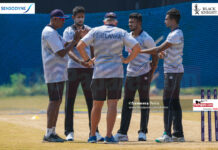The last rule changes in One-Day International cricket are nearly two and a half years old now, but teams are still struggling to come to terms with some of those changes. Or, more like, one of those changes – that of having only four players outside the circle in the 35 non-Power Play overs.
Teams have reconciled better to two new balls in each ODI innings even if that negates reverse swing and sometimes reduces the spinners to containing options, but having one lesser man out for 35 overs is something most sides and captains have struggled to adapt to. In instances where there is help from the surfaces, the fifth man inside has come in handy as teams have looked to attack and take wickets. But with most pitches across the world increasingly becoming flatter and flatter to facilitate booming strokeplay, individual and team scores are hitting an unprecedented high.
Mahendra Singh Dhoni, the longest serving skipper at this 2015 World Cup, made an impassionate plea to the authorities to amend that rule to restore a semblance of balance between bat and ball. Dhoni generally doesn’t speak his mind in public, but in a rare exception, he batted for a change to the existing rules. “It’s my personal opinion, I would like them to change,” the Indian skipper said a little after his side crashed out of the World Cup following their 95-run loss to Australia at the SCG on Thursday (March 26). “In the history of cricket, we had not seen a double hundred for a long time. In three years’ time, you see three 200s (actually four since the changes were made) being scored.
“A lot of people will say there are a lot of dot balls that are getting bowled because of that extra fielder inside. I would say have the option of having them outside, you can keep all 11 inside to stop all the dot deliveries,” he said with feeling. “We have to see. Let’s not make the 50-over game like a T20 game because I feel even a lot of sixes and a lot of fours makes it very boring.”
Dhoni made a strong case for 50-over cricket, saying it needed to be separated from the slam-bang Twenty20 format where it is one uninterrupted run feast from ball one to ball 120. ODI cricket, Dhoni pointed out, was designed to offer different challenges and therefore needed to be treated differently. “The main essence of ODI cricket is how you bat from the 15th over onwards, until maybe the 35th over. The first 10 and the last 10 doesn’t matter, it’s more like a T20, but the real essence of ODI cricket is how you bat in the middle overs,” he insisted. “You have to make sure that it’s still there present in the game, and I feel the rules are slightly harsh. Maybe slightly more harsh on the spinners who like to deceive batsmen with their flight, who like to challenge them. Now you have these batsmen playing sweeps, reverse sweeps and all these different shots, and they have an advantage. But you want power to dominate because that has been ODI cricket, more than the soft touches and all. You have the option as a captain; if you like this rule, you can bring the fielder inside.”
Earlier in the day, David Richardson, the chief executive of the International Cricket Council, had conceded that its Cricket Committee would review the playing conditions soon. “The cricket committee is going to look at the playing conditions again,” he told reporters. “One of the things we might look at is allowing an extra fielder out of the ring in the last 10 overs. That might be a sensible change.”
Dhoni stopped short of asking the authorities to revert to the previous rule, but made his stance very clear, giving the ICC plenty to think about.
Several captains have in the past spoken about the difficulty of managing a bowling innings with only four men out, but no one has chosen to bell the cat in the manner in which Dhoni has done. The timing of Dhoni’s comments are significant. They were not made after his side conceded 350 in each game of the World Cup for them to be considered the whine of a loser, but after they had taken 77 out of a possible 80 wickets; that they were made on the day his team went for 328 is nothing more than coincidental. Beyond a point, as this World Cup has repeatedly shown, 50-over cricket is not just about fours and sixes. It is also about wickets taken. A fifth fielder outside the circle will alone not solve that problem, you need pitches to be a little more bowler-friendly, but that is another matter altogether now, isn’t it?




















